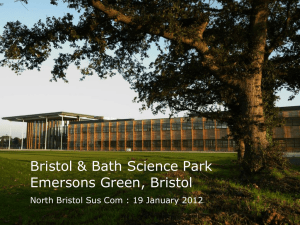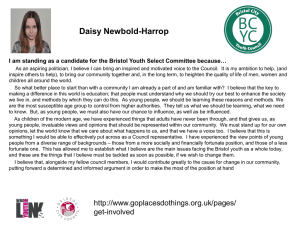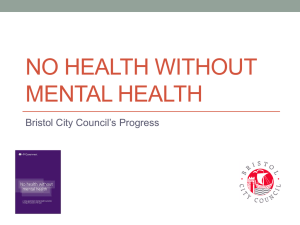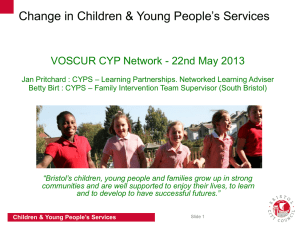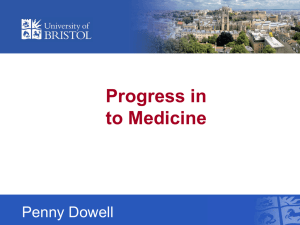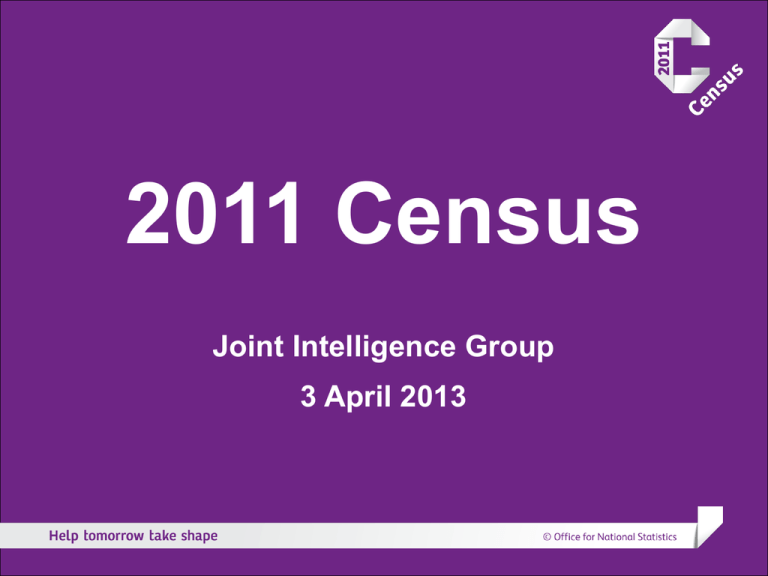
2011 Census
Joint Intelligence Group
3 April 2013
Presentation outline
Part 1
Results so far for Bristol
Part 2
Geography
Getting hold of the data
What data is coming next?
Bristol 2011 Census initial results
Census response rate
Total population (usual residents)
Living in households
Living in communal establishments
Short-term UK residents *
Total occupied households
93%
428,200
98%
2%
2,200
182,700
A usual resident of the UK is anyone who, on census day, was in the UK and had stayed or intended to stay in the
UK for a period of 12 months or more
* A short-term UK resident is anyone born outside the UK who has stayed or intends to stay in UK for a period of 3
months or more but less than 12 months
Census vs population estimates
450,000
Published Mid Year Estimates
445,000
Indicative Estimates
Population estimate
440,000
2011 Census
435,000
430,000
425,000
420,000
415,000
410,000
405,000
400,000
2006
2007
2008
2009
2010
2011
80+
75-79
70-74
65-69
60-64
55-59
50-54
45-49
40-44
35-39
30-34
25-29
20-24
15-19
10-14
5-9
0-4
Census vs Rolled Forward
Estimate by age
4,000
2,000
0
-2,000
-4,000
-6,000
-8,000
Population
12.0
Bristol %
England & Wales %
8.0
6.0
4.0
2.0
85+
80 - 84
75 - 79
70 - 74
65 - 69
60 - 64
55 - 59
50 - 54
45 - 49
40 - 44
35 - 39
30 - 34
25 - 29
20 - 24
15 - 19
10 - 14
5-9
0.0
0-4
% of total population
10.0
Age
Bristol = 7th largest city in England outside of London and 10th largest LA
Increased by 38,000 (9.7%) since 2001 (E%W 7.3%)
Median age = 33 years old (E&W 39)
78,700 children, 66,000 16-24 year olds, 9,000 people aged 85+
Population change
Largest ward: Lawrence Hill 18,942
Smallest ward: Stoke Bishop 9,269
Cabot increase: 62%
Lawrence Hill increase: 44%
These 2 wards account for 31% of population
increase in city since 2001
Average number of people per household: 2.3
Ethnicity
Ethnicity
Bristol BME population increased from 8.2% to 16%
8,000
4,000
0
-4,000
Other White
12,000
11,826
Black African
9,775
Mixed/multiple ethnic group
7,504
Other Black
5,986
Other Asian
3,271
Pakistani
2,813
Indian
1,952
Chinese
1,737
Any other ethnic group
1,231
Black Caribbean
1,142
Bangladeshi
874
White Irish
-470
White British
-1,653
Ethnicity
Lawrence Hill BME: 55%
Whitchurch Park BME: 4%
St Pauls Grosvenor Road BME: 80%
The Coots, Stockwood BME: 1.4%
Country of birth
63,000 (15%) of people in Bristol were born outside of UK (8% 2001)
- from more than 50 different countries
- 61% have arrived in UK since 2001
Countries of birth outside of UK
Poland
6,415
Somalia
4,947
India
3,809
Jamaica
3,279
Other EU accession countries
Ireland
Pakistan
Other EU member countries (March 2001)
Germany
3,025
2,900
2,770
2,478
2,329
On Census Day 4,947 people living in Bristol who were born in Somalia - 4th
highest number of all LAs after B’ham (7,765), Brent (6,855) & Ealing (6,468)
Religion (voluntary question)
At least 45 religions are represented in Bristol
1
2
3
4
5
6
7
8
9
10
Christian
No religion
Muslim
Hindu
Buddhist
Sikh
Jewish
Pagan
Mixed Religion
Spiritualist
Religion not stated
Bristol
200,254
160,218
22,016
2,712
2,549
2,133
777
575
415
376
34,782
%
46.8
37.4
5.1
0.6
0.6
0.5
0.2
0.1
0.1
0.1
8.1
Christians in Bristol down from 62% (2001) to 47% (2011)
No religion up from 25% to 37%
22,016 Muslims up from 2% to 5%
Bristol is ranked 7th in E&W for proportion stating no religion
2,310 Jedi Knights
Main Language
Main Language
Doesn’t include English !
Language
Main language spoken and English proficiency (also by household)
At least 91 main languages are spoken in Bristol
English is the main language spoken followed by Polish (6,080) and Somali
(5,004), also 1 Yiddish speaker and 1 Cornish speaker
9% of people do not speak English as their main language
6,089 (1.5%) people cannot speak English or cannot speak English very well
Language by ward
Health and disability
Proxy for disability:
People with a long-term health problem or disability
2011 question:
‘Are your day-to-day activities limited because of a
health problem or disability which has lasted, or is
expected to last, at least 12 months?
Include problems related to old age’
Yes, limited a lot
Yes, limited a little
No
Health and disability
20
18
17.8
16.7
16
13.1
14
12.4
12
10
8
6
4
2
0
Day-to-day activities are limited
2001
Day-to-day activities are limited: Age
16 to 64
2011
BUT numbers have increased
from 67,739 to 71,724
People with good or very good
health: 82.3%
Carers
45,000
40,000
9,176
35,000
30,000
7,842
5,253
25,000
3,859
20,000
15,000
23,643
25,709
10,000
5,000
0
2001
2011
Provides 1 to 19 hours unpaid care/week
Provides 20 to 49 hours unpaid care/week
Provides 50 or more hours unpaid care/week
The number of
people providing
unpaid care has
increased from
35,344 to 40,138
carers – 9.4% of all
people living in
Bristol
Economic activity
45.0
% population aged 16-74
40.0
35.0
30.0
25.0
20.0
15.0
10.0
5.0
0.0
Employee:
Part-time
Employee:
Full-time
Selfemployed
Unemploye
d
Full-time
student
Retired
Student
Looking
after home
or family
Long-term
sick or
disabled
Other
Bristol
13.4
39.8
8.4
4.3
4.8
9.8
9.0
3.9
4.3
2.3
E&W
13.7
38.5
9.7
4.4
3.4
13.8
5.8
4.3
4.2
2.2
Similar to national picture but more students and less retired
62% of people (16-74) are employed
Economically active up 67% (2001) to 71% (2011)
Full time employees part time employees self employed
Students
Students counted at term time
address
FT students (18+):
25,573 (6.7%) in 2001
35,638 (8.3%) in 2011
41% of total pop in Cabot
2% Brislington West
Majority of the population in
some LSOAs with large halls of
residence
Qualifications
4.9
No qualifications
20.2
32.8
11.9
% people qualified to degree level and above
Highest: Level 1 qualifications
LONDON
Highest: Level 2 qualifications
Bristol
38
33
Highest: Apprenticeship
Manchester
29
Highest: Level 3 qualifications
12.8
14.6
2.9
ENGLAND AND WALES
27
Newcastle upon Tyne
27
Leeds
27
Highest: Level 4 qualifications +
Highest: Other qualifications
No qualifications down from 26%
(2001) to 20% (2011) - E&W 23%
Degree level and above up from 24%
(2001) to 33% (2011) - E&W 27%
Sheffield
26
Birmingham
23
Liverpool
22
Nottingham
22
0
5
10
15
20
25
30
35
40
Method of travel to work
Other
0%
Bicycle/on foot
27%
Motorcycle, scooter
or moped
1%
Work mainly at or
from home
5%
Public transport
12%
Car driver or
passenger
(including taxi)
55%
Method of travel to work
70
Birmingham
60
Bristol
50
Leeds
40
Liverpool
Manchester
30
Newcastle
20
Nottingham
10
Sheffield
England and Wales
0
At or from home
Public transport
Car
Bicycle
On foot
1st out of all Core Cities for proportion of people cycling to work
1st out of all Core Cities for proportion of people walking to work
3rd for number cycling to work - after Cambridge + Hackney
3rd for number walking to work - after Birmingham + Leeds
12th for proportion of people cycling to work
Method of travel to work
Percentage share - change 2001-2011
2001
2011
60.0
50.0
40.0
30.0
20.0
10.0
0.0
Work
mainly
at/from
home
Public
Transport
Total
Car total
Bicycle
On foot
Motorcycle,
scooter or
moped
Other
Nationally public transport increased as a whole but commuting by bus or coach decreased.
The 10 local authorities with largest percentage point decreases in public transport use saw above
average increases in the percentage of people driving to work.
EXCEPT Bristol where walking and cycling increased.
Car availability
Average number of cars per household
1.40
1.25
1.17
1.20
1.04
1.01
1.00
0.97
0.93
0.82
0.80
0.76
0.74
0.73
Nottingham
Manchester
Liverpool
0.60
0.40
0.20
0.00
Bristol
Leeds
Sheffield
Birmingham
Newcastle
upon Tyne
West of
England
England and
Wales
25,196 more cars in Bristol than in 2001
29% of households do not have access to a car – 73% in St James Barton, 5% in Old Sneed Park
Housing Type
Change in Accommodation Type
2001
2011
70,000
60,000
50,000
40,000
30,000
20,000
10,000
0
Detached
Semi-detached
Terraced
Purpose-built
block of flats
Part of a
converted or
shared house
Flat in
commercial
building
Caravan or
temporary
structure
96% of household spaces are occupied by at least one usual resident
7,138 not occupied by usual residents
An additional 22,762 household spaces since 2001
82% of change has been in the form of flats
Flats = 34% of housing stock, up from 28% in 2001
Housing Change 2001-2011
43% of all change has been in
Ashley, Cabot, Lawrence Hill
and Easton
14% of all change has been in
Bedminster, Southville and
Windmill Hill
Tenure
Change in Tenure 2001 to 2011
%2001
70.0
60.0
%2011
63.0
54.8
50.0
40.0
30.0
22.9
24.9
20.3
14.2
20.0
10.0
0.0
Owned outright or buying
Social rented
Private rented and living rent free
Private renting has increased significantly from 14% to 25%
Privately rented (or LRF) doubled since 2001 to 45,600 households
Tenure
Owned
Stoke Bishop 83%
Lawrence Hill 20%
Social Rented
Lawrence Hill 48%
Stoke Bishop 3%
Private Rented or LRF
Clifton East 56%
Whitchurch Park 7%
Household size
• Average household size: 2.3 people
• Average number of rooms/household: 5.0
• Average number of bedrooms/household: 2.6
• 13% of households overcrowded - occupancy rating
of -1 rooms
• 33% of households overcrowded in Lawrence Hill
Household composition
35.0
30.0
% households
25.0
20.0
15.0
10.0
5.0
0.0
One person
household
Couple with
dependent
children
Couple no
dependent
children
Lone parent
household
Multi-person
household: All
full-time
students
Multi-person
household:
Other
Bristol
33.7
17.1
29.1
12.4
1.9
5.8
E&W
30.2
20.6
33.9
11.8
0.6
3.0
Part 2
Geography
Getting hold of the data
Bristol analysis
What data is coming next?
Census geography
Changes in OA and SOA boundaries in Bristol have taken place when:
i.
significant population change has occurred since the 2001 Census
ii.
areas have been independently assessed as lacking social homogeneity
Data sources may be for different geographies eg Indices of Deprivation 2010
by 2001 LSOA but 2011 Census by 2011 LSOAs.
Example: ‘St Pauls’ LSOA split into
i.
‘St Pauls City Road’
ii.
‘St Pauls Grovsenor Road’
iii.
‘St Pauls Portland Square’
For more information and maps see ‘2011 Geographies for 2011 Census data in Bristol’
Where to get the data: 1
BCC census web page www.bristol.gov.uk/census
Currently includes (PDFs!):
Briefing notes
Change since 2001
Data by topic themes for Bristol LA
Data for wards and Lower Super Output Areas
Maps
2011 Census Profiles by ward and link to tool.………
2011 Census Selected Statistics Tool
Excel tool for creating area profiles
Tool available on BCC 2011 Census web page
http://www.bristol.gov.uk/page/census-2011
Demo >>>>>>>>>
Where to get the data: 2
NOMIS https://www.nomisweb.co.uk/
Key Statistics and Quick Statistics
Detailed Statistics and Local Characteristics to come
Wizard query tool
Download one table at a time but for several areas
Where to get the data: 3
Neighbourhood Statistics
http://neighbourhood.statistics.gov.uk/
Data by topic for download
Postcode search for profiles
No crosstabulations!
Where to get the data: 4
Office for National Statistics (ONS)
http://www.ons.gov.uk/census/
Census Prospectus
Topic Reports
Data visualisations
Data Explorer Tool – available summer 2013
Planned analysis & reports - Bristol
2011 Census Atlas and/or series of ‘Topic Reports’
in discussion with individual teams including:
National and Core City comparisons
Change 2001-2011
LSOA maps
Topics: equalities communities, community cohesion,
housing, health, travel and transport, workforce and
jobs, students etc…..
2011 Census Publication Timetable
Release
Date
Description
Geography
First
release
July-Nov
2012
Population and Household summary - 5 year age bands and
sex, and occupied households estimates
All geographies
Second
release
Dec 2012 –
Feb 2013
Key Statistics (35 tables) & Quick Statistics (71 tables)
All geographies
Third
release
May 2013 to
July 2013
Detailed Characteristics (equivalent to 2001 Standard Tables),
Detailed Theme Tables and Armed Forces
Ward level and
above
Fourth
release
August 2013
to Oct 2013
Local Characteristics (equivalent to 2001 Census Area
Statistics)
All geographies
Further
releases
Nov 2013
onwards
Workplace and daytime populations, commuting,
commissioned tables
ONS Population Timetable
Release
Date
Description
Geography
LA Mid Year
Estimates
30 April 2013
2002-2010 MYE revised time series
LA and higher
June/July 2013
2012 Mid Year Estimate
LA and higher
11 April 2013
Mid-2011 SAPE
LSOA and higher
August/Sept
2013
2002-2010 SAPE revised time series
LSOA and higher
Sept/Oct 2013
Mid-2012 SAPE
LSOA and higher
May 2014
2012-based Sub-national Population
Projections
LA and higher
Autumn 2014
2012-based CLG Household projections
LA and higher
Small Area
Population
Estimates
Population
Projections
Contact details
Jayne Mills
Strategic Planning
Neighbourhoods and City Development
Bristol City Council
T: 0117 90 36873
E: jayne.mills@bristol.gov.uk
W: http://www.bristol.gov.uk/census

